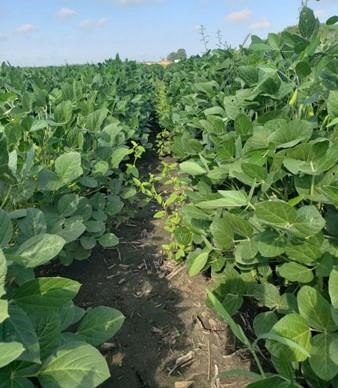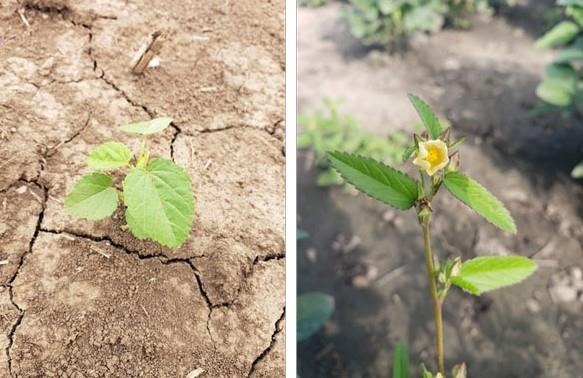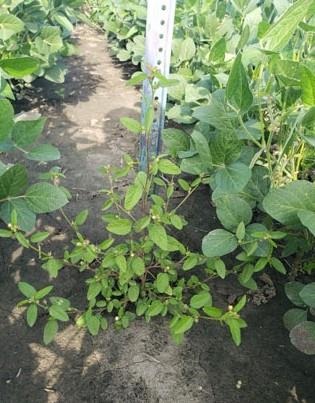By Sarah Lancaster
Conversations at a farmer meeting recently turned to the prevalence of prickly sida (also called teaweed) in some fields in southern Kansas (Figure 1). This month’s article will share some information about this weed and its management.

Figure 1. Prickly sida infestation in soybeans. Photo by Sarah Lancaster, K-State Research and Extension.
Ecology of Prickly sida
Prickly sida (Sida spinosa) is a warm-season annual plant in the mallow family, which is the same family as cotton, velvetleaf, and other plants found in Kansas. It can be found in fields, pastures, and roadsides in all but the western-most counties of Kansas. Prickly sida is native to North America.
Prickly sida emerges throughout the spring and summer. Germination of fresh seed was greatest after 15 days at 100/77 °F compared to lower temperatures evaluated. Wet/dry cycles over the next 112 days increase germination compared to seeds that were kept moist. Chilling for 30 days did not increase germination.
Identification
Prickly sida seedlings have two heart-shaped cotyledons with a small notch in the tip of each. The first true leaves are egg-shaped to triangular, but more mature leaves are lance-shaped to oval (Figure 2). Prickly sida can be distinguished from velvetleaf seedlings by the presence of soft, dense hairs on velvetleaf leaves. Hophornbeam copperleaf is also similar but seedlings have opposite leaves. Mature leaves are about 3/4 to 2 inches long by 1/3 to 3/4-inch-wide with serrate margins and prominent veins on the underside. Leaves are alternately arranged on the stem.

Figure 2. Prickly sida seedling with egg-shaped leaves (left) and mature plant with lance-shaped leaves (right). Photos by Sarah Lancaster, K-State Research and Extension.
Stems are typically 7 to 40 inches tall with many branches (Figure 3). There are short, spine-like projections called stipules at the base of each petiole beginning with the third leaf. Petioles are about half as long as the leaf.

Figure 3. Mature prickly side plants have many branches. Photo by Sarah Lancaster, K-State Research and Extension.
Yellow flowers form at the base of each petiole throughout the summer. Flowers have five petals and may occur alone or in clusters. When flowers mature, they form a capsule-like fruit with five parts. Each part has a single seed. Each capsule has two sharp spines on the top.
Management
Research conducted in Kansas during 1969 and 1970 suggests that prickly sida reduces soybean yield by about 10% if it emerges within 10 days of planting. Prickly sida that emerged later was less competitive. Similarly, cotton yields were only reduced by season-long interference of 64 plants per 40 feet (the greatest density studied) in experiments conducted in Mississippi during 1973 and 1974.
Recently published research conducted in Louisiana reported that prickly sida control was 89 to 95% approximately 1 month after planting when glyphosate was applied at planting alone or with Envive (Valor + Classic + Harmony). By 2 months after planting, glyphosate-based post-emergence herbicide applications resulted in prickly sida control ranging from 86 to 79% for glyphosate only applications at planting and 89 to 86% for glyphosate + Envive. Other herbicides that are effective on prickly sida include sulfentrazone, metribuzin, Basagran, Cobra, and Liberty. Group 2 resistance was reported in prickly sida from Georgia in 1993.
Source : ksu.edu